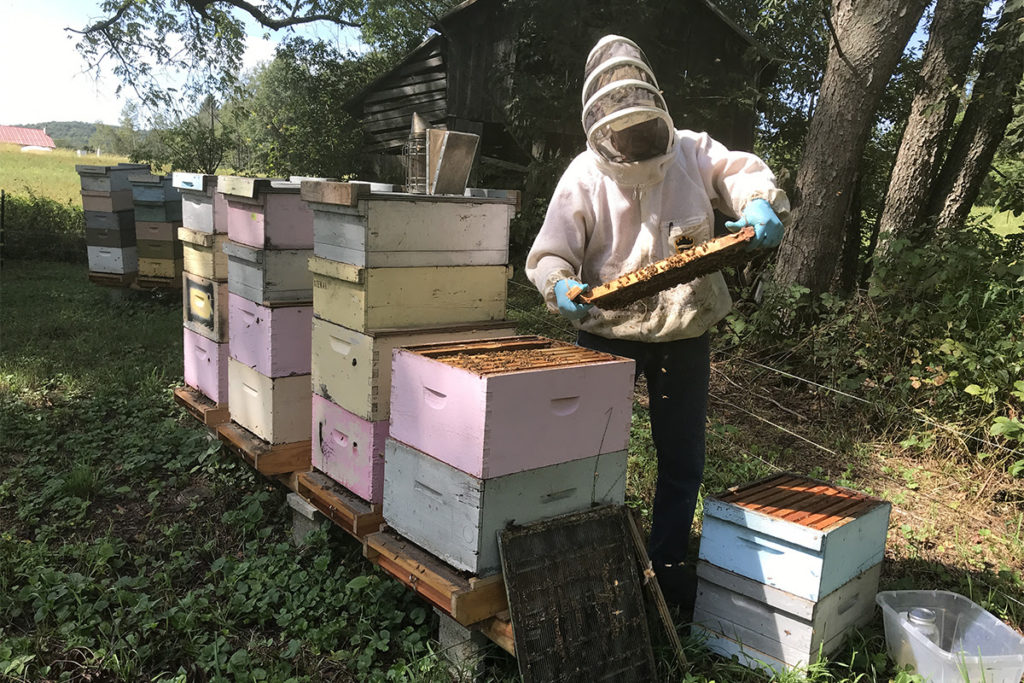
Jan 18, 2022Almond growers welcome news of the arrival of bees
Semi-truck loads of commercial honeybee colonies are arriving in California from across the country to prepare bees for pollination of this year’s almond crop.
“We’re getting ready for the big event,” said Placer County beekeeper John Miller of Miller Honey Farms in Newcastle. “We’ve got this window of really good weather, and so I’m sure everyone is going as quickly as they are able, to get these in and start taking care of the bees. This is just a golden opportunity to awaken those hives with fresh feed and fresh pollen substitute to stimulate brood rearing.”
During the next few weeks, beekeepers will finish moving some 2.5 million honeybee colonies into California orchards to pollinate the state’s 1.3 million bearing acres of almond trees during bloom. California beekeepers supply about 500,000 honeybee colonies, and the remainder is trucked in from out of state.
Miller, who winters bees in North Dakota and Idaho, said his commercial beekeeping operation is the first in the nation to test a modification for expedited passage through the California Agricultural Inspection Stations. He said 87% of all bees pass through the station at Truckee as they enter California.
Miller said three years ago he worked with the California Department of Food and Agriculture to develop a preinspection program to expedite loads of commercial honeybees coming into the state.
“Pest exclusion employees logged all the loads by hand on two computers, and it worked really, really well, but we still had congestion and delays,” Miller said, adding that the program went smoother this year with some trial adjustments. He said the updated version will likely serve as a template for 2023. “About eight loads have passed through, and they seem to be going through in one minute. It’s so much better.”
Almond bloom typically occurs from mid-February to mid-March , and beekeepers say it is too early to tell whether recent sunny temperatures will trigger an early bloom since nighttime temperatures remain low. Beekeepers prepare for whatever Mother Nature has in store.
“We’re all excited about this early California snow and rain and hoping for some more here towards the end of the month,” said Tulare County beekeeper Roger Everett. “We’ve decided we’re going to plug ahead and see where the cards fall and make sure we’re in a position to be ready to make it work.”
As far as determining hive strength, Everett said beekeepers typically discern this as they make their way through the hives.
“We’re checking them, feeding them and seeing how things are looking. When you’re dealing with a living commodity, a lot of times we’ll look at the brood and think, ‘We’re going to have a hatch out, and this hive is going to build up in the next week,'” Everett said. “Sometimes it may not go how you want it to.”
Overwintering honeybees in climate-controlled buildings is beneficial for bee health, Miller said.
“It’s a deeply restful state for the colony because it’s dark inside the building at all times, and the temperature is the same at all times,” Miller said. “There’s no stimulation or cadence of daylight and dark, and bees are not expending energy and resources looking for something that’s not there.”
Annual honeybee losses happen each year due to challenges facing the apiary sector such as reduced forage, mite and disease pressures and unintended exposure to crop-protection materials.
Rory Crowley, director of habitat programs for Project Apis m., a nonprofit organization dedicated to honeybee research, said, “We’re losing habitat left and right.”
Crowley, also of the Nicolaus Nut Co. in Chico, said Project Apis m. works with almond growers to plant more forage in their orchards through the Seeds for Bees program, which he said helps beekeepers and farmers.
Following two years of drought, beekeepers said they are pleased with the atmospheric river storms that brought much-needed snow and precipitation, which helps get plants started for spring and benefits bees by providing a diverse source of forage.
Butte County beekeeper Buzz Landon said many apiarists had to purchase more feed for bees and in advance.
“This fall, you had to schedule your syrup loads three weeks out, and people weren’t getting loads of syrup when they needed to, so that was a little bit frustrating, and prices have gone up,” said Landon, president of the California State Beekeepers Association. “Our inputs are going up tremendously, so we are trying to cover those costs. The real big price jump was the price in freight to haul bees.”
The cost for almond growers for an eight-frame hive this year, Landon said, could be between $200 to $220 each.
Beekeepers should be aware that this year, California agricultural officials will begin assessing civil penalties for violations of laws in effect since 2019 to protect bees.
Commercial beekeepers who place colonies into crops for pollination must comply with the BeeWhere program, which tracks and safeguards hives using mapping tools. Beekeepers must register annually with the county agricultural commissioner, clearly mark hives with name, address and phone number, and notify the county within 72 hours of hive relocation.
“BeeWhere is a program that we’re all using,” Landon said. “I think it’s in everybody’s best interest to register the location of bees. From what I understand, if it’s your first offense, the ag commissioners are going to issue warnings. But if you’re a repeat offender, then now they can start assessing penalties.”
– Christine Souza, California Farm Bureau Federation







